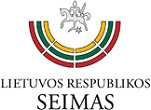|
Antanas Smetona, President of the Republic of Lithuania, Members of the Presidium of the Fourth Seimas at the solemn sitting. Kaunas, around 1938. Unknown photographer |
The elections to the Fourth Seimas were held on 9–10 June 1936. The first sitting took place in the building of the Seimas and the Ministry of Justice in Kaunas on 1 September 1936.
The Fourth Seimas consisted of 49 members.
Konstantinas Šakenis served as Speaker of the Fourth Seimas.
The Fourth Seimas was elected after a nine-year interruption. President Antanas Smetona, having dissolved the Third Seimas on 12 April 1927, was slow in announcing new parliamentary elections. The elected Seimas was not a democratic parliament but rather served as part of the executive assisting the President in exercising his powers. The spring session of the Fourth Seimas closed on 31 May 1940. The President of the Republic was supposed to convene the Seimas to a new session. However, he was prevented from doing it because Lithuania was occupied on 15 June 1940. Justas Paleckis, the then President of the Republic, on the basis of the 1938
Constitution of Lithuania, signed a decree of 27 June 27, whereby the Fourth Seimas was dissolved on 1 July 1940 m.
ELECTIONS TO THE FOURTH SEIMAS
In the mid-1930s, with the continuing agrarian unrest in the Suvalkija Region coupled with the pressure from the population and opposition parties to hold elections, there came an increasing need to summon the Seimas. On 9 May 1936, the President of the Republic of Lithuania endorsed a new law on parliamentary elections and set the date for the elections to the Fourth Seimas. Under the law, however, public organisations and citizens’ groups were barred from standing in elections to the Seimas. The elections were held on 9–10 June 1936. A nominal list of candidates (a total of 144) standing for election to the Seimas by constituencies and counties was published in the official gazette Vyriausybės žinios on 3 June 1936.
COMPOSITION OF THE FOURTH SEIMAS AND THE PRESIDIUM
On 3 July 1936, the President of the Republic signed a decree setting the date for convening the Seimas, “I hereby call upon [...] to take the oath of a representative of the nation on 1 September 1936, at 10 a.m., and convene the first sitting of the Seimas to be held in the building of the Seimas in Kaunas on 1 September 1936, at 12 p.m.”. The total of 49 members was elected in the non-democratic elections, with 42 parliamentarians representing the Lithuanian Nationalist Union and 3 of them representing the Klaipėda Region. Unlike in previous parliamentary elections, no women were elected to the Fourth Seimas. Moreover, although there were proposals for the representatives of the nation to establish parliamentary groups, which would deal with economy, culture, and business, or which would be based on professional affiliation, no political groups were formed in the Fourth Seimas as the parliament was considered to be ‘non-partisan’. The first sittings of the Seimas were chaired by the interim Presidium, which was appointed by Prime Minister Juozas Tūbelis. At the sitting of 23 September 1936, the parliamentarians elected a permanent Presidium and appointed Konstantinas Šakenis as Speaker of the Seimas.
ACHIEVEMENTS OF THE FOURTH SEIMAS
Laws issued by the President of the Republic severely restricted the work of the Seimas. The Seimas was not in a position to draft a Statute of the Seimas autonomously. Moreover, the 1938 Constitution of Lithuania limited the role of the Seimas. Of all the laws adopted by the Seimas in 1936–1940, as much as 91.3% of them were submitted by the Council of Ministers, while parliamentarians submitted barely 8.7% of laws, all of which required prior coordination with the Government. During its four-year mandate, the Seimas adopted only one law which had not been pre-coordinated with the Council of Ministers. That was an amendment of 4 October 1938 to the Statute of the Institute of Lithuanian Studies, naming the Institute after President Antanas Smetona.
References:
Apygardų apskričių kandidatų į tautos atstovus sąrašai, Vyriausybės žinios, 1936 06 03, Nr. 537.
Respublikos Prezidento aktai, Vyriausybės žinios, 1936 05 09, Nr. 533.
Respublikos Prezidento aktas (1936 07 03), Vyriausybės žinios, 1936 07 07, Nr. 539.
Truska Liudas, IV Seimas (1936–1940), Didysis Lietuvos parlamentarų biografinis žodynas, t. 3, Lietuvos Respublikos Seimų I (1922–1923), II (1923–1926), III (1926–1927), IV (1936–1940) narių biografinis žodynas, Vilnius, 2007.
Prepared by Vilma Akmenytė-Ruzgienė


 Scheduled broadcasts
Scheduled broadcasts







